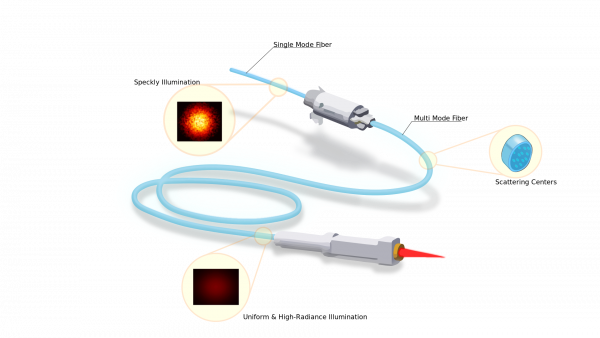Ideal Light Source – De-coherence without time averaging for high radiance uniform light source
Imaging of microscopic structures, photography, and excitation of materials benefit from a uniform and high-power light source. Since lasers are high radiance light sources, they are good candidates for these purposes. However, their high coherence results in speckles; a nonuniform intensity.
Spectral Radiance is the thermodynamic quantity describing illumination and is defined as the power of the radiation per wavelength per solid angle per area.
Looking on this definition we see the inherent tradeoff between high radiance and uniformity. High radiance source requires a narrow spectral and angular width, which results in high coherence and speckles. Conventionally, speckles reduction is done by a time average of a fast moving element which is time-consuming (For example a rotating diffuser combined with a slow detector).
Our aim is to reduce the coherence instantaneously, thereby allowing fast and uniform illumination.
Our solution is taken from the diffusion process, described by a “Random walk” behavior. Consider an ensemble of random walkers starting at a point location and time. In time, they spread in a diffusive form. More important, looking at meeting events between different walkers, as time evolves the average time difference between walkers increases. Assuming short memory (Drunk random walkers), after some time of evolution, the meetings occur between walkers that do not recognize each other. Going back to photonics, coherent light propagating in a diffused media acquires Optical Path Difference (OPD) that increases in time. After sufficient propagation, the average OPD exceeds the coherence length, which results in incoherent interaction and the elimination of speckles.
Specifically, we design a multi-mode fiber which contains pre-designed static scattering centers along its propagation axis. Propagation through the fiber volume, filled with these centers, results in different OPD acquired by different components of light fields. By engineering the centers, so that the standard deviation of the OPD is proportional to the coherence length of the light source, we achieve orders of magnitude reduction in the coherence of light, while maintaining its high radiance.

